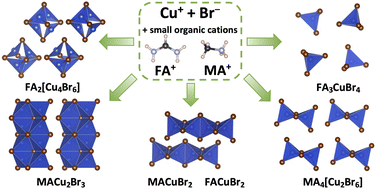Exceptional structural diversity of hybrid halocuprates(i) with methylammonium and formamidinium cations†
Abstract
Hybrid halocuprates(I) are nowadays the subject of intensive studies as promising materials for various optoelectronic applications. This class of materials is characterized by wide structural diversity enabled by a great variety in the size and shape of organic cations. Therefore, the study of composition–structure–property relationships is a key step for the rational design of new halocuprate materials with desired properties. In this paper, we comprehensively studied MABr/CuBr and FABr/CuBr systems (MA+ = methylammonium and FA+ = formamidinium) and established the existence of five novel phases (namely, MACu2Br3, FA2[Cu4Br6], MACuBr2, FACuBr2, and FA3CuBr4) related to four different structural types and three distinct A+ : Cu+ stoichiometries (A+ = MA+/FA+). The optical properties of the discovered phases are studied by absorption and low-temperature photoluminescence spectroscopy. Based on a crystal–chemical analysis, we explained a unique structural diversity of the MA- and FA-based bromocuprates, as well as revealed new structure–property relationships.



 Please wait while we load your content...
Please wait while we load your content...